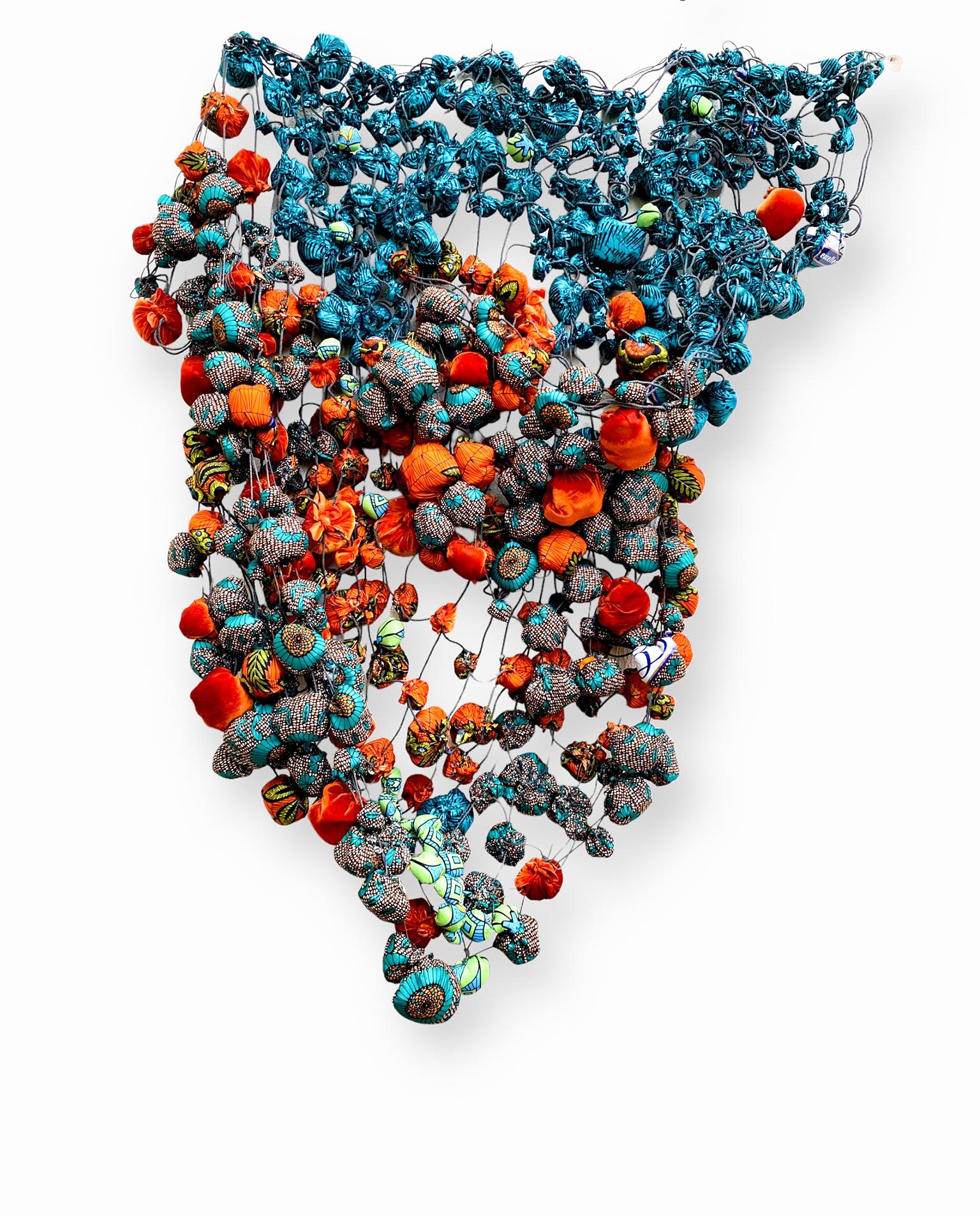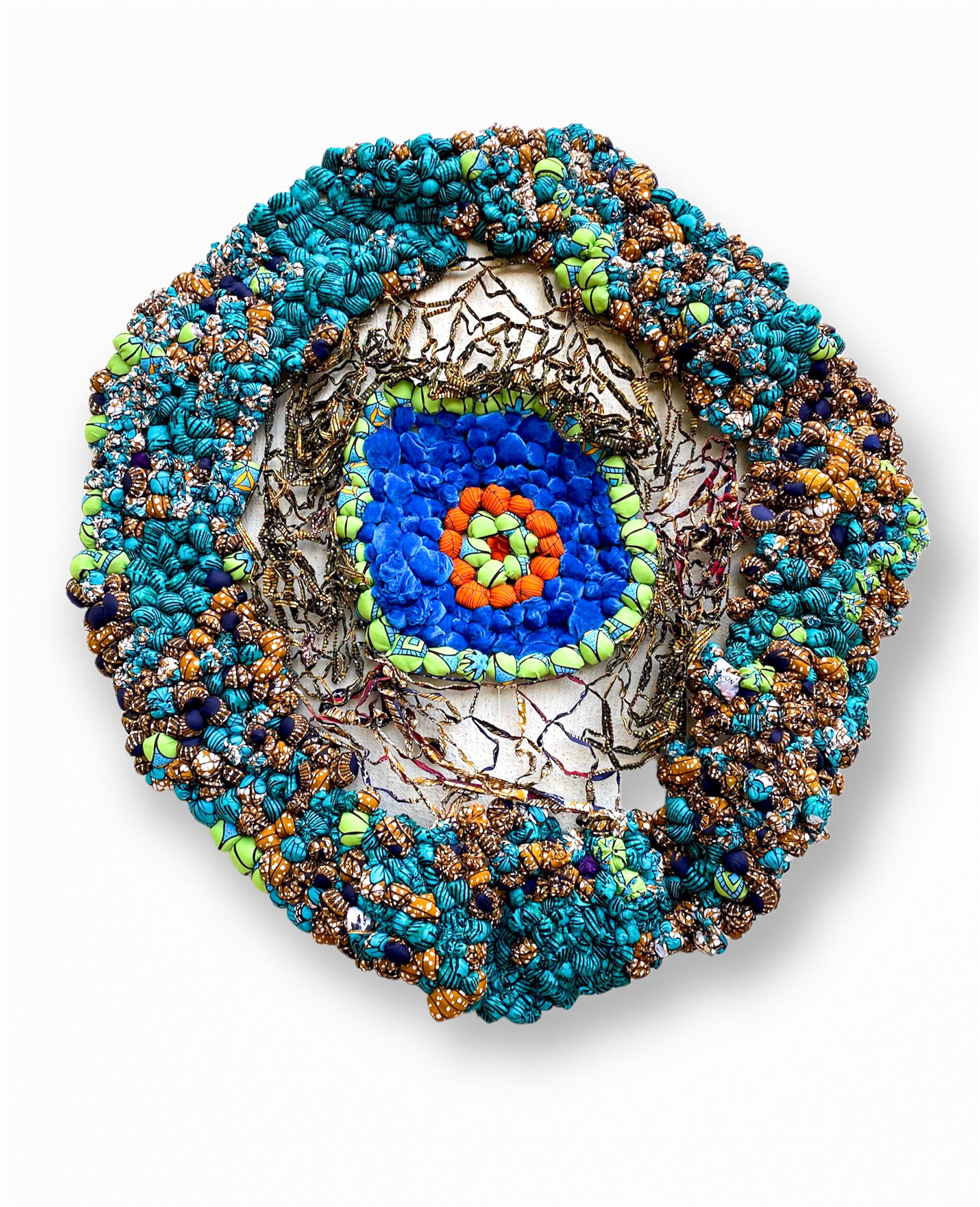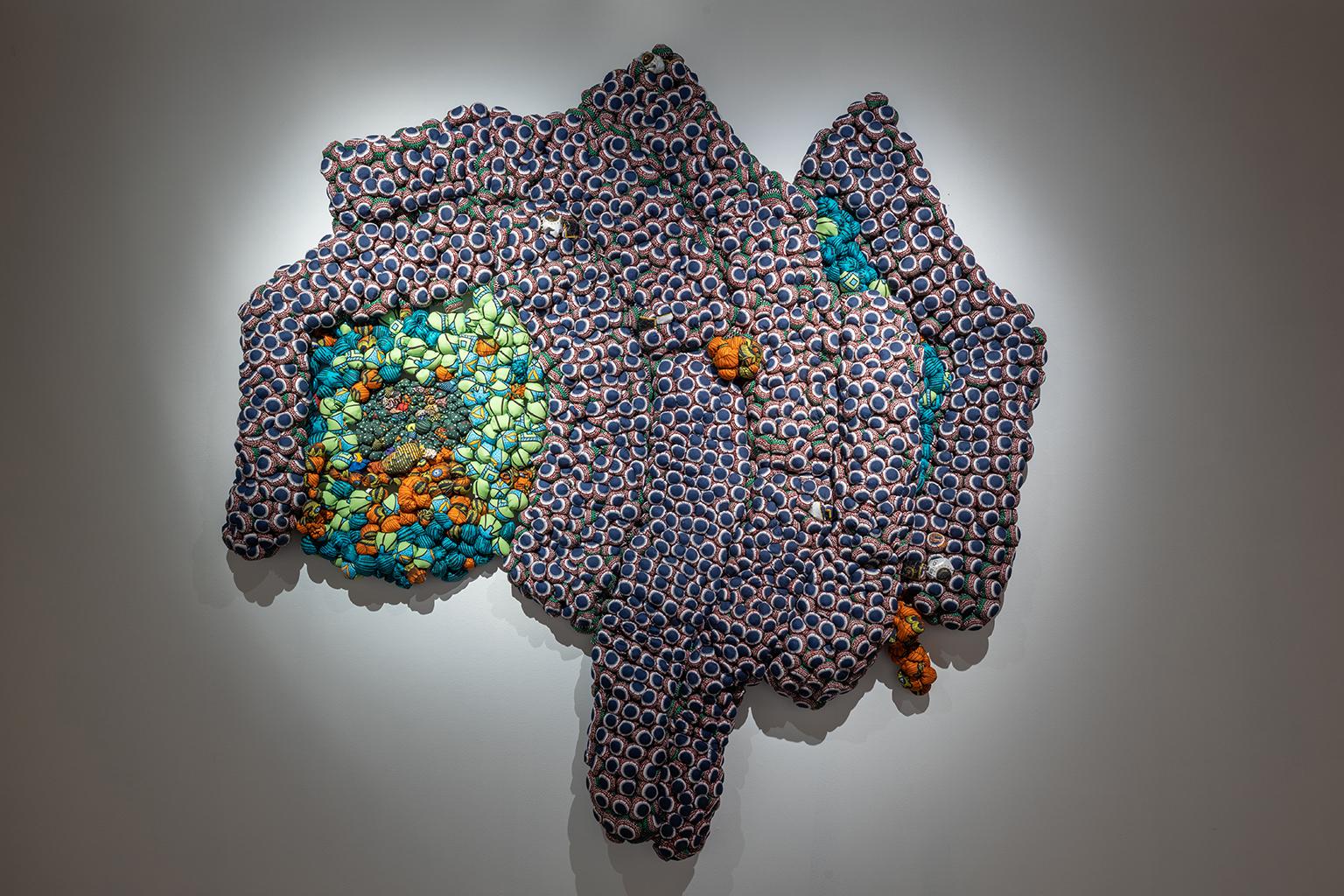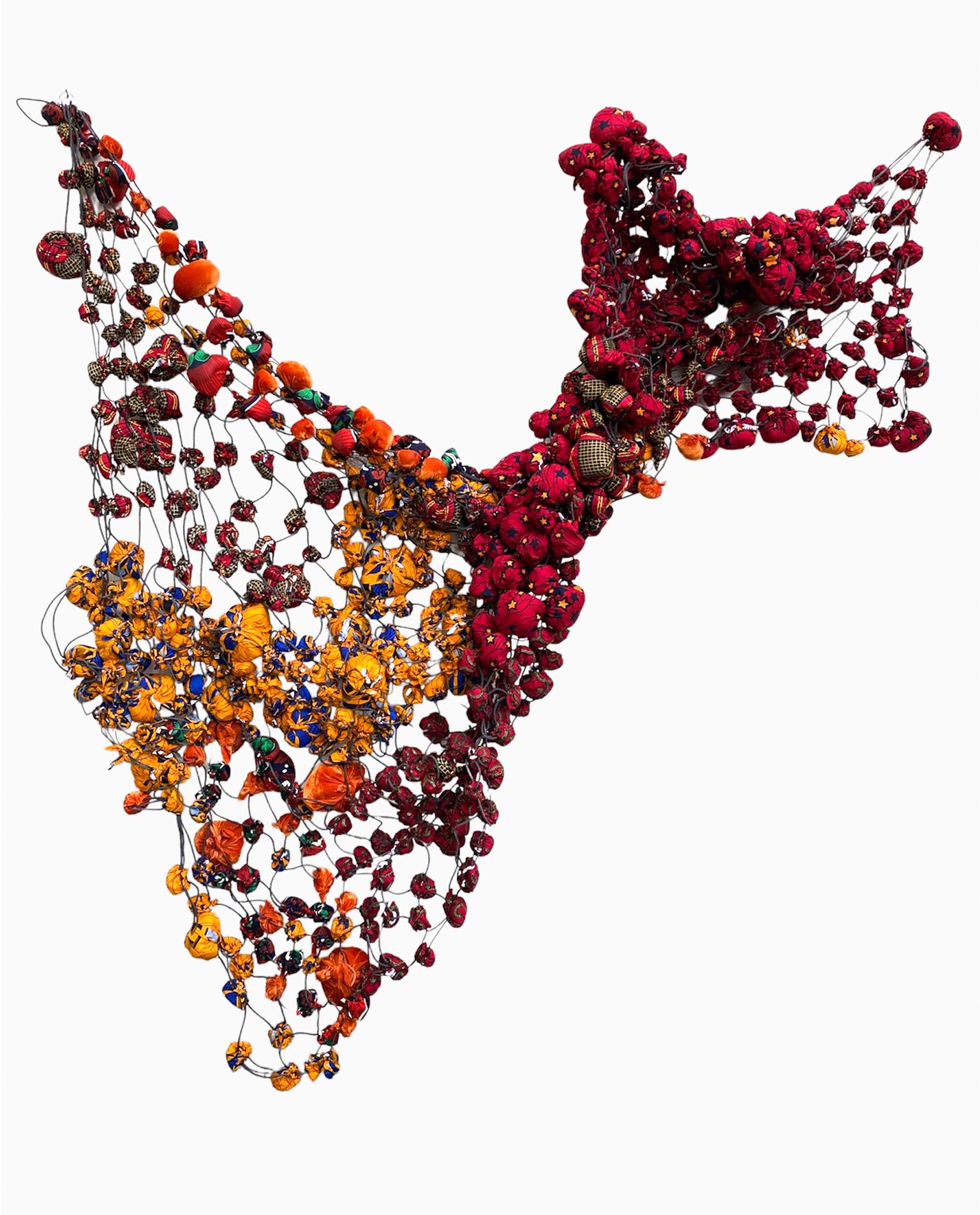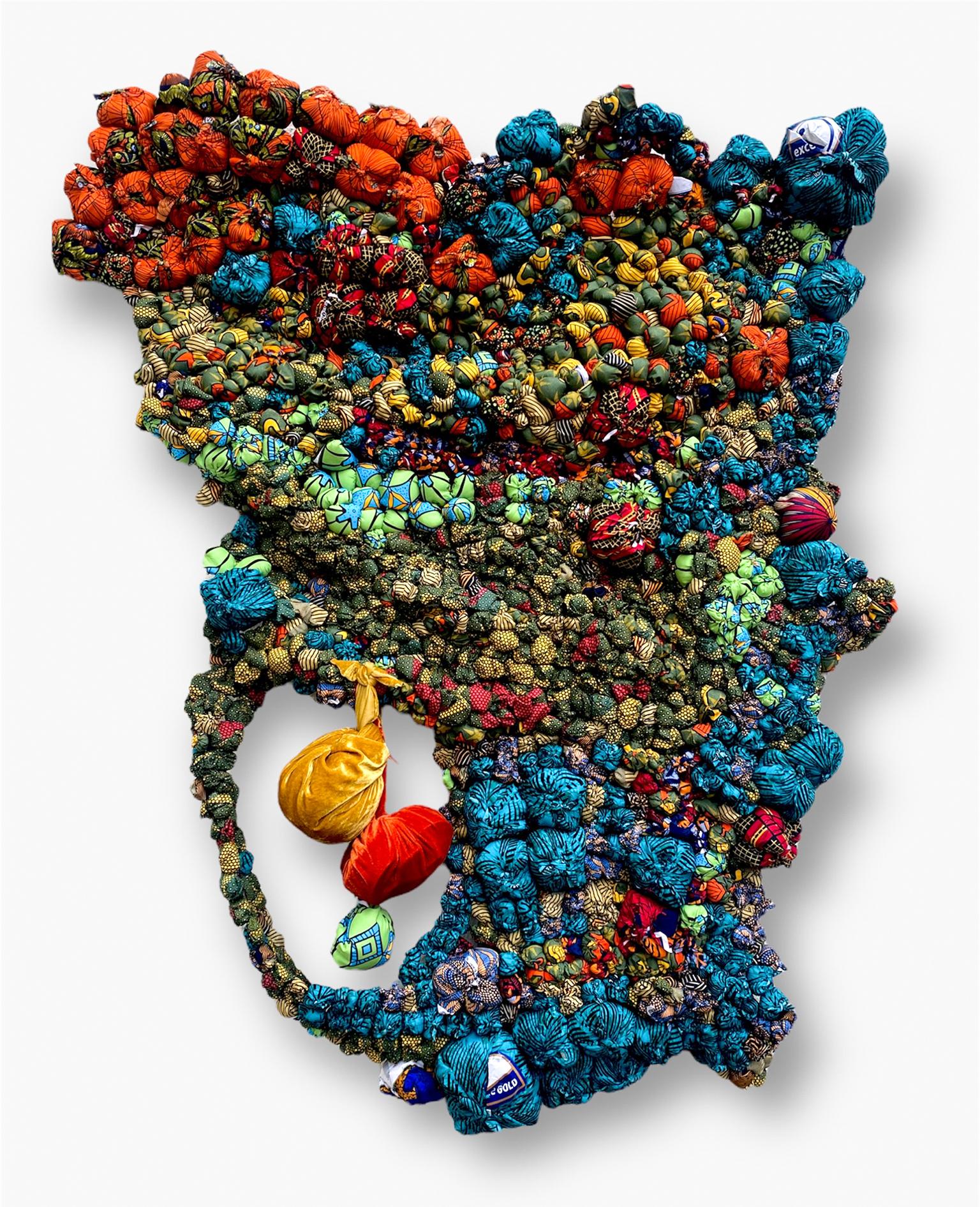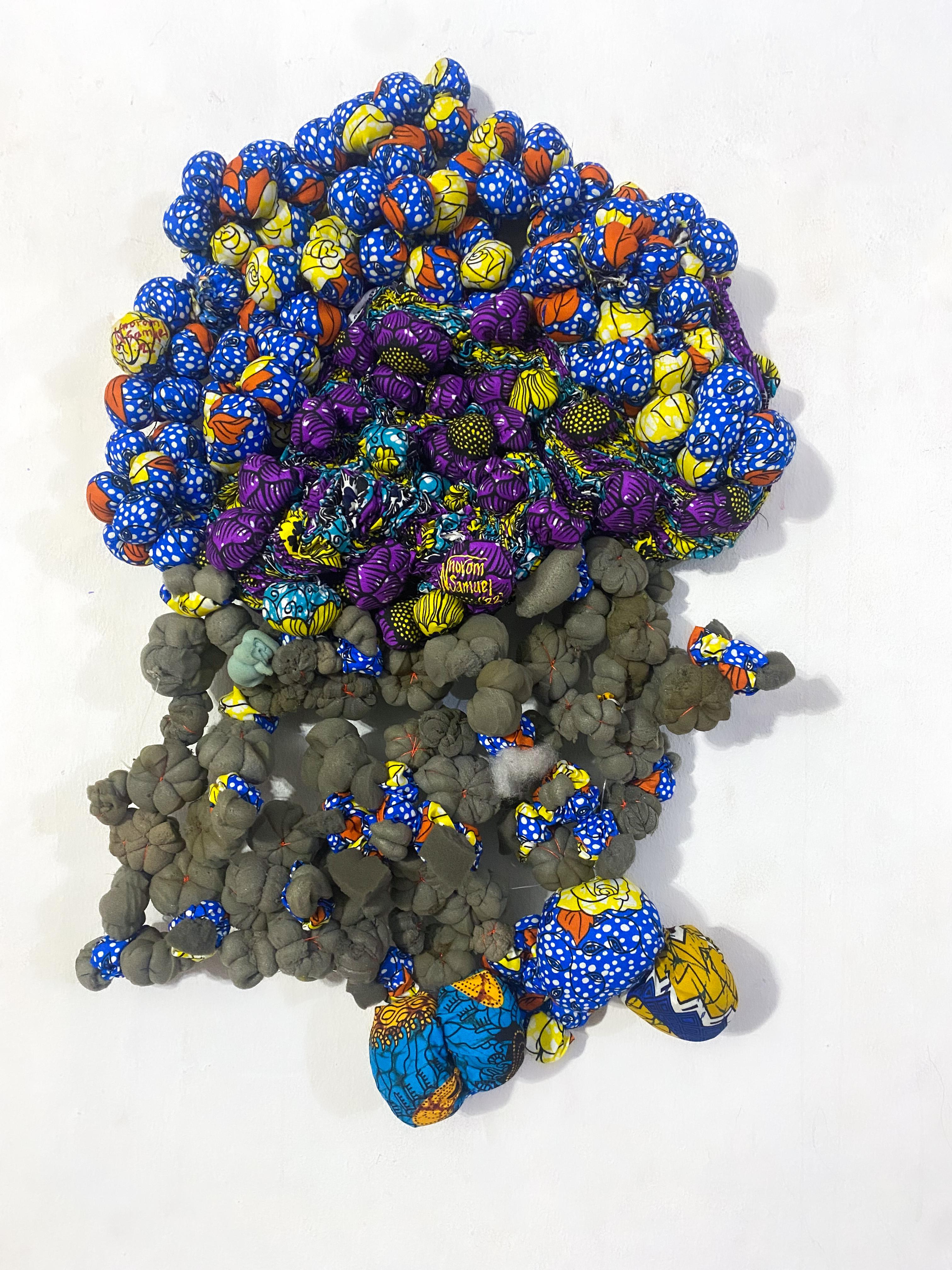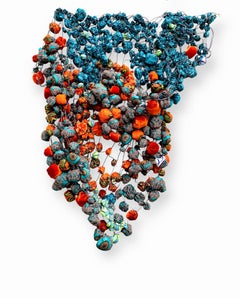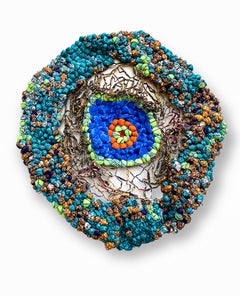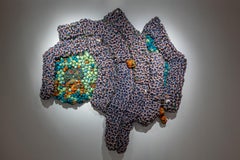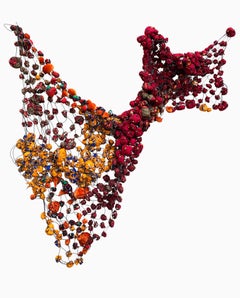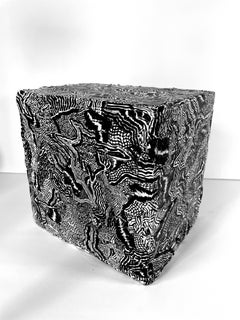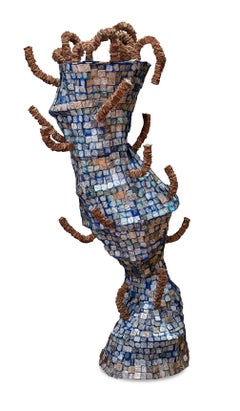Want more images or videos?
Request additional images or videos from the seller
1 of 3
Samuel NnoromSuckers and2023
2023
Price Upon Request
Price Upon Request
Price Upon Request
Price Upon Request
Price Upon Request
Price Upon Request
Price Upon Request
Price Upon Request
Price Upon Request
Price Upon Request
About the Item
As a child growing up in Nigeria, Samuel Nnorom’s artistic sensibilities emerged from observing the creative processes of his father, a shoemaker, and his mother, a tailor. Realizing his natural propensity for life drawing and sewing through these early explorations, Nnorom later developed his artistic skillset in art school, apprenticeships, and residencies. An element of his practice that has remained constant throughout his career is his dedication to textiles and their capacity as social agents in society.
Points of Departure presents a new body of textile sculptures made from Ankara/African wax fabric sourced from tailors or from off-cast clothing that is wrapped around recycled foam into balls or “bubbles” of various dimensions. These textile orbs are formed into clusters that appear like dense land masses with differently coloured textiles suggesting people, mountains, streams, islands, and peninsulas. Ankara fabric has a unique origin story; while it came from the Dutch who manufactured the wax cotton for the Indonesian textile market, its eventual descent into Central and West Africa during the 19th century was where the fabric flourished and became iconic of the Region. Ankara fabric is popular in clothing, particularly dresses, shirts, and headscarves, and is known for its bold prints and bright colours.
As a fabric that is used to drape the body, it is noteworthy that Nnorom sees the weft and weave of his fabrics as akin to a social structure. In his latest work, Nnorom looks at how his sculptures can be considered a metaphor for a “fabric of society,” made up of individual lives united in space. In particular, Points of Departure explores human survival through processes of migration, considering how the involuntary upheaval of human lives connects people despite their social or cultural backgrounds. For him, the history and social statement relayed in each Ankara fabric print becomes a visual language much like a written text.
Nnorom’s work intersects the boundaries between tapestry, painting, and sculpture, similar to the way his work surpasses the bounds of representation, symbols, or exact points of reference. The methods he uses to cluster the orbs in space vary greatly: some are densely packed like Never Walk Alone (2023) and Brothers Keeper (2023), while others are spaced apart and connected by web-like tendrils as seen in Throw and Catch (2023) and Meeting Points (2023). The multitude of variations through colour, scale, and form demonstrate Nnorom’s capacity to push his chosen material and artistic strategy into infinite directions. The exhibition title, Points of Departure, is an apt sentiment for not only his interest in the intersection between textiles and human migration but for how this exhibition showcases the artist’s propulsion towards this new direction in his practice.
- Creator:Samuel Nnorom (1990, Nigerian)
- Creation Year:2023
- Dimensions:Height: 53.5 in (135.89 cm)Width: 53.5 in (135.89 cm)Depth: 2.8 in (7.12 cm)
- Medium:
- Movement & Style:
- Period:
- Condition:
- Gallery Location:Montreal, CA
- Reference Number:1stDibs: LU47612311412
Samuel Nnorom (b.1990) is a Nigerian-born visual. He discovered his talent at the age of 9 years while assisting his father in his shoe workshop – where he started making life drawings of customers that visited the shop. He was also influenced by his mother's tailoring workshop –as a kid who played with colourful fabrics with sewing needles and thread. He went further to develop this talent through apprenticeship, training, workshops, Exhibitions, art school and practice. Samuel holds an MFA in sculpture from the University of Nigeria Nsukka and is a full-time practising studio artist with many awards, exhibitions and residencies which include 3rd and 1st prize for the National Gallery of Art 2010 and 2012 respectively, won prizes in 2016, 2017 and 2019 editions of the Life in My City Art Festival. He was the first prize recipient (leatherwork category) of the Icreate Africa 2019. Nnorom has received invitations to important workshops and group exhibitions, including the international art workshop by IICD at the United States Embassy, Abuja (2019), Rele Young Contemporary Bootcamp 2021, published in an international magazine the UK (zine, issue 11, artist responding to issues) and Haus-a-rest, issue 17 Material Damage 2021, Cassirer Welz Award, Bag factory and Strauss & co South Africa 2022, recipient of 2022 Royal Over-Sea League and Art House Residency London, recipient of Guest Art Space (GAS) fellowship and residency from Yinka Shonibare Foundation 2022, shortlisted for Prince Claus Funds CAREC and Mentorship 2022/2023, Noldor fellowship and Residency 2023, and several others. He belongs to the New Nsukka School of Art and he is currently exploring Okirika clothes and Ankara fabric using bubble techniques as sculptural media while interrogating human experiences that relate to consumption, environment, sociopolitical and economic issues through questioning.
About the Seller
5.0
Vetted Professional Seller
Every seller passes strict standards for authenticity and reliability
Established in 1996
1stDibs seller since 2014
105 sales on 1stDibs
Typical response time: <1 hour
- ShippingRetrieving quote...Shipping from: Montreal, Canada
- Return Policy
Authenticity Guarantee
In the unlikely event there’s an issue with an item’s authenticity, contact us within 1 year for a full refund. DetailsMoney-Back Guarantee
If your item is not as described, is damaged in transit, or does not arrive, contact us within 7 days for a full refund. Details24-Hour Cancellation
You have a 24-hour grace period in which to reconsider your purchase, with no questions asked.Vetted Professional Sellers
Our world-class sellers must adhere to strict standards for service and quality, maintaining the integrity of our listings.Price-Match Guarantee
If you find that a seller listed the same item for a lower price elsewhere, we’ll match it.Trusted Global Delivery
Our best-in-class carrier network provides specialized shipping options worldwide, including custom delivery.More From This Seller
View AllStill Holding
Located in Montreal, Quebec
As a child growing up in Nigeria, Samuel Nnorom’s artistic sensibilities emerged from observing the creative processes of his father, a shoemaker, and hi...
Category
2010s Contemporary Abstract Sculptures
Materials
Textile
Price Upon Request
Goes Around, comes around
Located in Montreal, Quebec
As a child growing up in Nigeria, Samuel Nnorom’s artistic sensibilities emerged from observing the creative processes of his father, a shoemaker, and hi...
Category
2010s Contemporary Abstract Sculptures
Materials
Textile
Price Upon Request
Survival
Located in Montreal, Quebec
As a child growing up in Nigeria, Samuel Nnorom’s artistic sensibilities emerged from observing the creative processes of his father, a shoemaker, and hi...
Category
2010s Contemporary Abstract Sculptures
Materials
Textile
Price Upon Request
Throw and Catch
Located in Montreal, Quebec
As a child growing up in Nigeria, Samuel Nnorom’s artistic sensibilities emerged from observing the creative processes of his father, a shoemaker, and hi...
Category
2010s Contemporary Abstract Sculptures
Materials
Textile
Price Upon Request
Brothers Keeper
Located in Montreal, Quebec
As a child growing up in Nigeria, Samuel Nnorom’s artistic sensibilities emerged from observing the creative processes of his father, a shoemaker, and hi...
Category
2010s Contemporary Abstract Sculptures
Materials
Textile
Price Upon Request
If e like e Good or Bad
Located in Montreal, Quebec
As a child growing up in Nigeria, Samuel Nnorom’s artistic sensibilities emerged from observing the creative processes of his father, a shoemaker, and hi...
Category
2010s Contemporary Abstract Sculptures
Materials
Textile
Price Upon Request
You May Also Like
"Eko" 2022
By David Paul Kay
Located in New York, NY
David Paul Kay "Eko" 2022
Mix media
About the artist
About the Artist
David Paul Kay is an American contemporary artist based in New York City. With a focus on vibrant lines an...
Category
2010s Contemporary Abstract Sculptures
Materials
Mixed Media
French Contemporary Sculpture by Eric Beauplace - Résonances Végétales #1
By Eric Beauplace
Located in Paris, IDF
Mixed media: linen canvas, acrylic paint, wood, mirrored acrylic glass, polished stainless steel
Eric Beauplace is a French contemporary plastic artist born in 1962 who lives & work...
Category
2010s Contemporary Abstract Sculptures
Materials
Mixed Media
Used to be Amazon Boxes, Original Abstract Sculpture, 2021
By Sam Silberstein
Located in Boston, MA
Artist Commentary:
During the COVID-19 pandemic I decided to collect boxes from around my neighborhood and repurpose the cardboard material. By utilizing materials that would otherwi...
Category
21st Century and Contemporary Abstract Abstract Sculptures
Materials
Mixed Media, Cardboard
Maquette for Laureate (unique sculpture)
By Seymour Lipton
Located in New York, NY
Seymour Lipton
Maquette for Laureate, ca. 1968-1969
Nickel silver on monel metal
Unique
18 × 8 1/2 × 7 inches
Marlborough-Gerson Gallery, New York
Acquired from the above by the previous owner, 1969
thence by descent
Christie's New York: Monday, June 30, 2008 [Lot 00199]
Acquired from the above Christie's sale This unique sculpture by important Abstract Expressionist sculptor Seymour Lipton is a maquette of the monumental sculpture "Laureate" - one of Lipton's most iconic and influential works located on the Riverwalk in downtown Milwaukee, Wisconsin. Laureate is a masterpiece that was commissioned by the Allen-Bradley Company in memory of Harry Lynde Bradley and as an enhancement for the newly constructed Performing Arts Center. It is located on the east bank of the Milwaukee River at 929 North Water Street. The Bradley family in Milwaukee were renowned patrons of modernist sculpture, known for their excellent taste who also founded an eponymous sculpture park. For reference only is an image of the monumental "Laureate" one of Milwaukee's most beloved public sculptures. According to the Smithsonian, which owns a different unique variation of this work, "The full-size sculpture Laureate was commissioned by the Marcus Center for the Performing Arts in Milwaukee. In the initial drawings, Seymour Lipton combined details from the architectural plan with a wide variety of images, ranging from musical instruments to a lighthouse on the island of Tobago. He transformed the basic shapes from these sketches into a welded sculpture, which evokes a figure composed of columns, harp strings, and coiled rope. Lipton created this piece to celebrate achievement in the arts. The dramatic silhouette commands your attention, reflecting the title Laureate, which means worthy of honor and distinction. The final version of the piece is over twelve feet high and stands out against the pale, flat buildings of the arts center.,,"
Provenance
Marlborough-Gerson Gallery, New York
Acquired from the above by the previous owner, 1969
thence by descent
Christie's New York: Monday, June 30, 2008 [Lot 00199]
Acquired from the above Christie's sale
About Seymour Lipton:
Born in New York City in 1903, Seymour Lipton (1903-1986) grew up in a Bronx tenement at a time when much of the borough was still farmland. These rural surroundings enabled Lipton to explore the botanical and animal forms that would later become sources for his work. Lipton’s interest in the dialogue between artistic creation and natural phenomena was nurtured by a supportive family and cultivated through numerous visits to New York’s Museum of Natural History as well as its many botanical gardens and its zoos. In the early 1920s, with the encouragement of his family, Lipton studied electrical engineering at Brooklyn Polytechnic Institute and pursued a liberal arts education at City College. Ultimately, like fellow sculptor Herbert Ferber, Lipton became a dentist, receiving his degree from Columbia University in 1927. In the late 1920s, he began to explore sculpture, creating clay portraits of family members and friends.
In addition to providing him with financial security, dentistry gave Lipton a foundation in working with metal, a material he would later use in his artwork. In the early 1930s, though, Lipton’s primary sculptural medium was wood. Lipton led a comfortable life, but he was also aware of the economic and psychological devastation the Depression had caused New York. In response, he generally worked using direct carving techniques—a form of sculpting where the artist “finds” the sculpture within the wood in the process of carving it and without the use of models and maquettes. The immediacy of this practice enabled Lipton to create a rich, emotional and visual language with which to articulate the desperation of the downtrodden and the unwavering strength of the disenfranchised. In 1935, he exhibited one such early sculpture at the John Reed Club Gallery in New York, and three years later, ACA Gallery mounted Lipton’s first solo show, which featured these social-realist-inspired wooden works. In 1940, this largely self-taught artist began teaching sculpture at the New School for Social Research, a position he held until 1965.
In the 1940s, Lipton began to devote an increasing amount of time to his art, deviating from wood and working with brass, lead, and bronze. Choosing these metals for their visual simplicity, which he believed exemplified the universal heroism of the “everyman,” Lipton could also now explore various forms of abstraction. Lipton’s turn towards increasing abstraction in the 1940s allowed him to fully develop his metaphorical style, which in turn gave him a stronger lexicon for representing the horrors of World War II and questioning the ambiguities of human experience. He began his metal work with cast bronze sculptures, but, in 1946, he started welding sheet metal and lead. Lipton preferred welding because, as direct carving did with wood, this approach allowed “a more direct contact with the metal.”[ii] From this, Lipton developed the technique he would use for the remainder of his career: “He cut sheet metal, manipulated it to the desired shapes, then joined, soldered, or welded the pieces together. Next, he brazed a metal coating to the outside to produce a uniform texture.”[iii]
In 1950, Lipton arrived at his mature style of brazing on Monel metal. He also began to draw extensively, exploring the automatism that abstract expressionist painters were boasting at the time. Like contemporaries such as Jackson Pollock, Lipton was strongly influenced by Carl Jung’s work on the unconscious mind and the regenerative forces of nature. He translated these two-dimensional drawings into three-dimensional maquettes that enabled him to revise his ideas before creating the final sculpture.The forms that Lipton produced during this period were often zoomorphic, exemplifying the tension between the souls of nature and the automatism of the machine.
In the years following the 1950s, Lipton’s optimism began to rise, and the size of his work grew in proportion. The oxyacetylene torch—invented during the Second World War—allowed him to rework the surfaces of metal sculptures, thus eliminating some of the risks involved with producing large-scale finished works. In 1958, Lipton was awarded a solo exhibition at the Venice Biennale and was thus internationally recognized as part of a small group of highly regarded avant-garde constructivist sculptors. In 1960, he received a prestigious Guggenheim Award, which was followed by several prominent public commissions, including his heroic Archangel, currently residing in Lincoln Center’s David Geffen Hall.
A number of important solo exhibitions of his work followed at The Phillips Collection in Washington, DC (1964); the Milwaukee Art Center and University of Wisconsin, Milwaukee (1969); the Virginia Museum of Fine Arts in Richmond (1972); the Everson Museum in Syracuse, NY (1973); the Herbert E. Johnson Museum of Art of Cornell University in Ithaca, NY (1973); the National Collection of Fine Arts, Smithsonian Institution (now the Smithsonian American Art Museum) in Washington, DC (1978); and a retrospective in 1979 at The Jewish Museum in New York. In 1982 and 1984 alone, two exhibitions of his sculpture, organized respectively by the Mint Museum (Charlotte, NC) and the Hillwood Art Gallery of Long Island University (Greenvale, NY), traveled extensively across museums and university galleries around the nation. In 2000, the traveling exhibition An American Sculptor: Seymour Lipton was first presented by the Palmer Museum of Art of Pennsylvania State University in University Park. Most recently, in 2009, the Ackland Art Museum in Chapel Hill, NC mounted The Guardian and the Avant-Garde: Seymour Lipton’s Sentinel II in Context.
Since 2004, Michael Rosenfeld Gallery has been the exclusive representative of the Estate of Seymour Lipton and has presented two solo exhibitions of his work—Seymour Lipton: Abstract Expressionist Sculptor (2005) and Seymour Lipton: Metal (2008). In 2013, Michael Rosenfeld Gallery presented Abstract Expressionism, In Context: Seymour Lipton, which included twelve major sculptures by the artist, along with works by Charles Alston, Norman Bluhm, Beauford Delaney, Willem de Kooning, Jay DeFeo, Michael Goldberg, Adolph Gottlieb, Hans Hofmann, Lee Krasner, Norman Lewis, Conrad Marca-Relli, Boris Margo, Alfonso Ossorio, Richard Pousette-Dart, Milton Resnick, Charles Seliger...
Category
1960s Abstract Expressionist Abstract Sculptures
Materials
Metal, Silver
This Rock is in a Hard Place, Original Abstract Sculpture, 2021
By Sam Silberstein
Located in Boston, MA
Artist Commentary:
During the COVID-19 pandemic I decided to collect boxes from around my neighborhood and repurpose the cardboard material. By utilizing materials that would otherwi...
Category
21st Century and Contemporary Abstract Abstract Sculptures
Materials
Mixed Media, Cardboard
Assiduosly without words
By L.G.
Located in Paris, FR
One of a kind Blown and fused Glass Sculpture in brown/black, bluish black, opaque white and White sandblasted.
Includes its black metal base ( about 32 cm X 10 cm X 18 cm ).
Tota...
Category
2010s Abstract Abstract Sculptures
Materials
Blown Glass
More Ways To Browse
Metaphores Fabric
Miller Wood Sculpture
Nathan James
Niijima Floats
Ron Chapel Bronze
Stephen White Sculpture
Von Zadora
Wade Ceramic
Waterfall Sculpture
Wayne Edge
White Patina Bronze Sculpture
Wood Wall Art Vertical
Abstract Self Portrait Sculpture
Adam Henein
Alois Kronschlaeger
Benjamin Cobb
Bertoia Chime
Carlos Aguilar
